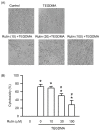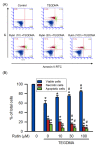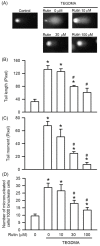Protective Effect of Rutin on Triethylene Glycol Dimethacrylate-Induced Toxicity through the Inhibition of Caspase Activation and Reactive Oxygen Species Generation in Macrophages
- PMID: 36233071
- PMCID: PMC9570090
- DOI: 10.3390/ijms231911773
Protective Effect of Rutin on Triethylene Glycol Dimethacrylate-Induced Toxicity through the Inhibition of Caspase Activation and Reactive Oxygen Species Generation in Macrophages
Abstract
Rutin, also called quercetin-3-rhamnosyl glucoside, is a natural flavonol glycoside present in many plants. Rutin is used to treat various diseases, such as inflammation, diabetes, and cancer. For polymeric biomaterials, triethylene glycol dimethacrylate (TEGDMA) is the most commonly used monomer and serves as a restorative resin, a dentin bonding agent and sealant, and a bone cement component. Overall, TEGDMA induces various toxic effects in macrophages, including cytotoxicity, apoptosis, and genotoxicity. The aim of this study was to investigate the protective mechanism of rutin in alleviating TEGDMA-induced toxicity in RAW264.7 macrophages. After treatment with rutin, we assessed the cell viability and apoptosis of TEGDMA-induced RAW264.7 macrophages using an methylthiazol tetrazolium (MTT) assay and Annexin V-FITC/propidium iodide assay, respectively. Subsequently, we assessed the level of genotoxicity using comet and micronucleus assays, assessed the cysteinyla aspartate specific proteinases (caspases) and antioxidant enzyme (AOE) activity using commercial kits, and evaluated the generation of reactive oxygen species (ROS) using a dichlorodihydrofluorescein diacetate (DCFH-DA) assay. We evaluated the expression of heme oxygenase (HO)-1, the expression of nuclear factor erythroid 2 related factor (Nrf-2), and phosphorylation of AMP activated protein kinase (AMPK) using the Western blot assay. The results indicated that rutin substantially reduced the level of cytotoxicity, apoptosis, and genotoxicity of TEGDMA-induced RAW264.7 macrophages. Rutin also blocked the activity of caspase-3, caspase-8, and caspase-9 in TEGDMA-stimulated RAW264.7 macrophages. In addition, it decreased TEGDMA-induced ROS generation and AOE deactivation in macrophages. Finally, we found that TEGDMA-inhibited slightly the HO-1 expression, Nrf-2 expression, and AMPK phosphorylation would be revered by rutin. In addition, the HO-1 expression, Nrf-2 expression, and AMPK phosphorylation was enhanced by rutin. These findings indicate that rutin suppresses TEGDMA-induced caspase-mediated toxic effects through ROS generation and antioxidative system deactivation through the Nrf-2/AMPK pathway. Therefore, rutin has the potential to serve as a novel antitoxicity agent for TEGDMA in RAW264.7 macrophages.
Keywords: TEGDMA; antioxidant system; apoptosis; cytotoxicity; genotoxicity; macrophage; reactive oxygen species; rutin.
Conflict of interest statement
The authors declare no conflict of interest.
Figures








Similar articles
-
Activation of stress-regulated transcription factors by triethylene glycol dimethacrylate monomer.Biomaterials. 2011 Mar;32(7):1787-95. doi: 10.1016/j.biomaterials.2010.11.031. Epub 2010 Dec 10. Biomaterials. 2011. PMID: 21145583
-
Rutin-protected BisGMA-induced cytotoxicity, genotoxicity, and apoptosis in macrophages through the reduction of the mitochondrial apoptotic pathway and induction of antioxidant enzymes.Environ Toxicol. 2021 Jan;36(1):45-54. doi: 10.1002/tox.23009. Epub 2020 Aug 24. Environ Toxicol. 2021. PMID: 32830914
-
NADPH oxidase 4 is involved in the triethylene glycol dimethacrylate-induced reactive oxygen species and apoptosis in human embryonic palatal mesenchymal and dental pulp cells.Clin Oral Investig. 2015 Jul;19(6):1463-71. doi: 10.1007/s00784-014-1370-7. Epub 2014 Dec 3. Clin Oral Investig. 2015. PMID: 25467236
-
Genetic and cellular toxicology of dental resin monomers.J Dent Res. 2006 Oct;85(10):870-7. doi: 10.1177/154405910608501001. J Dent Res. 2006. PMID: 16998124 Review.
-
The protective effects of rutin on the liver, kidneys, and heart by counteracting organ toxicity caused by synthetic and natural compounds.Food Sci Nutr. 2022 Sep 15;11(1):39-56. doi: 10.1002/fsn3.3041. eCollection 2023 Jan. Food Sci Nutr. 2022. PMID: 36655104 Free PMC article. Review.
Cited by
-
Identification, Antioxidant and Immunomodulatory Activities of a Neutral Exopolysaccharide from Lactiplantibacillus plantarum DMDL 9010.Nutrients. 2025 Jul 9;17(14):2265. doi: 10.3390/nu17142265. Nutrients. 2025. PMID: 40732890 Free PMC article.
-
Influence of dual-cure resin-cement curing modes on gingival cytotoxicity and inflammatory responses.J Dent Sci. 2025 Jan;20(1):586-595. doi: 10.1016/j.jds.2024.04.019. Epub 2024 Apr 30. J Dent Sci. 2025. PMID: 39873103 Free PMC article.
-
Phytochemical Profiling and Biological Evaluation of Dianthus sylvestris subsp. aristidis: A Chromatographic and Mass Spectrometry Approach to Uncovering Bioactive Metabolites for Dermatological and Metabolic Disorder Management.Pharmaceuticals (Basel). 2025 Apr 16;18(4):578. doi: 10.3390/ph18040578. Pharmaceuticals (Basel). 2025. PMID: 40284013 Free PMC article.
-
Structural, antioxidant, and immunomodulatory activities of an acidic exopolysaccharide from Lactiplantibacillus plantarum DMDL 9010.Front Nutr. 2022 Dec 8;9:1073071. doi: 10.3389/fnut.2022.1073071. eCollection 2022. Front Nutr. 2022. PMID: 36570157 Free PMC article.
-
Green Synthesis and Characterization of Silver Nanoparticles Using Anchusa Officinalis: Antimicrobial and Cytotoxic Potential.Int J Nanomedicine. 2025 Apr 12;20:4481-4502. doi: 10.2147/IJN.S511217. eCollection 2025. Int J Nanomedicine. 2025. PMID: 40242607 Free PMC article.
References
MeSH terms
Substances
Grants and funding
LinkOut - more resources
Full Text Sources
Research Materials

